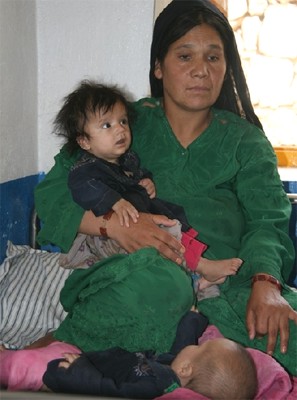KABUL - Afghanistan has the highest fertility rate in Asia - 6.7 - which not only means the deaths of thousands of young mothers and infants every year but also poses long-term challenges, an expert of the UN Population Fund (UNFPA) warned.

An Afghan mother with her twin daughters in Daikundi Province (Photo: Masoud Popalzai/IRIN)
Ramesh Penumaka, UNFPA’s country representative, said the average Afghan woman gives birth to 6-7 children and if this trend were to continue Afghanistan’s current estimated population of 26 million would surpass 56 million by 2050.
“If the fertility rates are not reduced, Afghanistan’s population will more than double by 2050; from 47th most populous country, Afghanistan would become the 31st most populous country in the world,” Penumaka said.
A substantial increase in the population rate would more than double demand for land and water, exacerbate pressure on the infrastructure and adversely affect the environment, experts said.
“Continued rapid population growth poses a bigger threat to poverty reduction in most countries than HIV/AIDS,” the UNFPA said in a statement on World Population Day, 11 July.
The UNFPA said slower population growth would help the least developed countries like Afghanistan to invest properly in children’s health, education and progress, and reduce the maternal and infant mortality rate, as well as HIV infection rates.
High maternal mortality
After Sierra Leone, Afghanistan has the highest maternal mortality rate in the world with at least 1,600 deaths per 100,000 live births, according to UNFPA and the UN Children’s Fund (UNICEF).
“That is a staggering 24,000 women dying every year, and 87 percent of them [deaths] are preventable,” Ramesh Penumaka told reporters in Kabul on 14 July.
Lack of access to obstetric and health services, early marriages and multiple short-term pregnancies are the main reasons why about 60 mothers die every day.
UNFPA said birth intervals of at least 36 months would contribute to a considerable reduction in maternal and infant mortality rates.
“Research shows that birth spacing saves lives by allowing mothers to space their children to healthier intervals, improving the lives of women and their children,” UNFPA said. “Access to contraceptives empowers women. It can also save their life.”
Poor health services
Afghanistan’s Public Health Ministry says basic health services reach up to 85 percent of the country, but only 18 percent of deliveries were attended by skilled birth attendants in 2007, UNFPA’s statistics show.
Most pregnant women do not have access to skilled health care and obstetric services due to a lack of awareness, access problems and/or men’s unwillingness to take females to health centres.
“The key to better maternal health lies with the men, who have to be sensitive to the health problems and the needs of women,” Penumaka said.
Early marriages
Up to 50 percent of Afghan girls get married before they are 15; some are married at the age of eight, UNFPA has found.
Consequently many young mothers, who also have little access to health care, nutrition and other services, die due to pregnancy-related complications.
Early marriages also contribute to high infant mortality rates; 165 in every 1,000 infants die before their first birthday, according to UNICEF.



